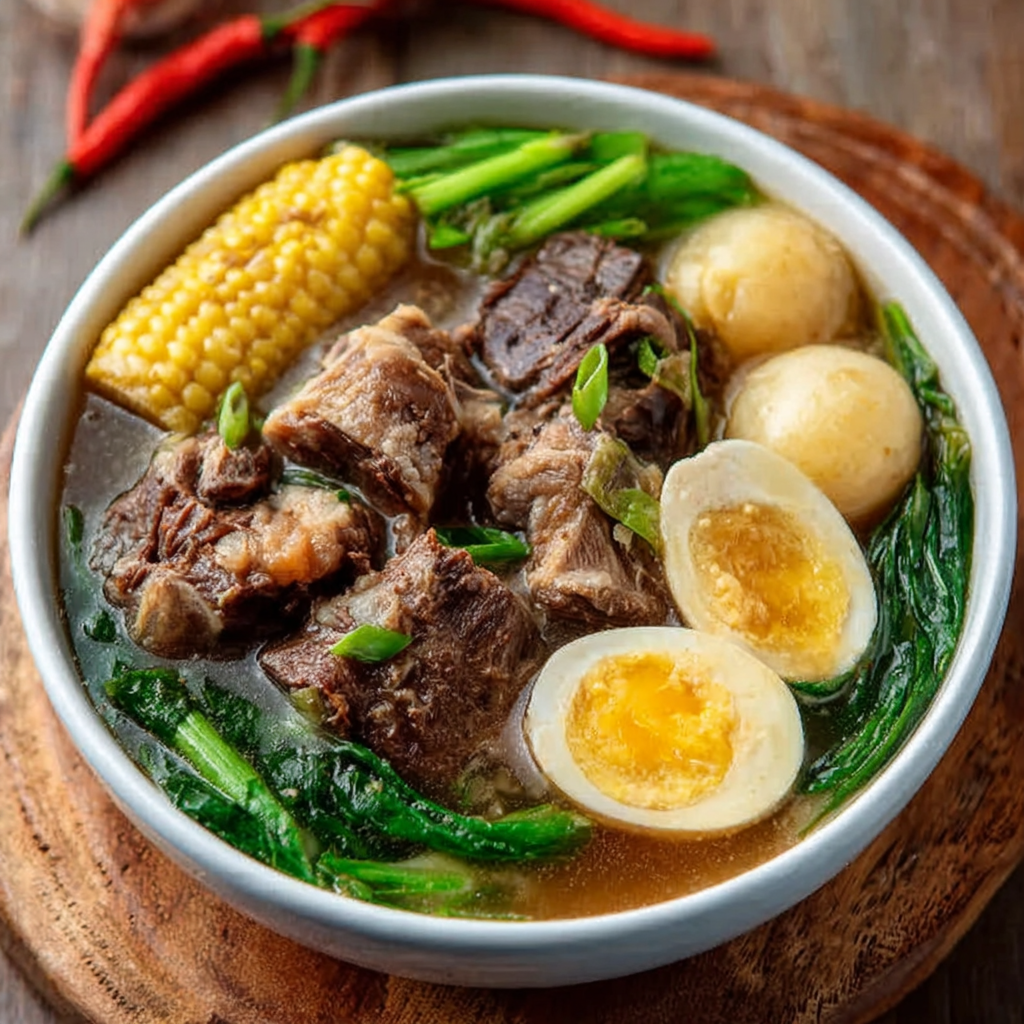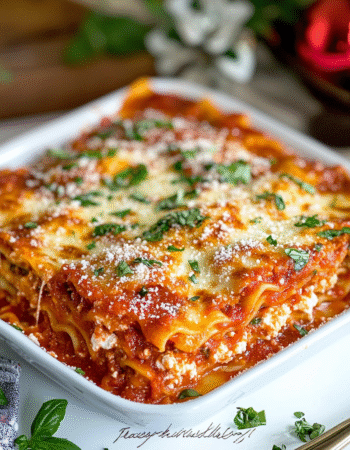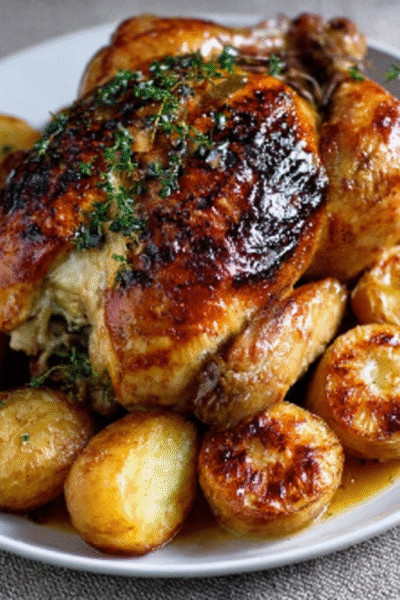Nilagang Baka: Discover the Flavorful Beef Stew Recipe!

php
How to Make Nilagang Baka
Now that you’re excited about this comforting Filipino beef stew, let’s dive into the nitty-gritty of making Nilagang Baka. I promise, it’s easier than you might think! With just a few simple steps, you’ll have a hearty meal simmering away, filling your kitchen with mouthwatering aromas. So, grab your apron, and let’s get started!
Step 1 – Prep Ingredients
First things first, let’s prep our ingredients. Start by cutting your beef shank or short ribs into chunks. I like to use a sharp knife and a sturdy cutting board for this. It’s like a mini workout, and trust me, it’s worth it! You want those pieces to be about 1.5 to 2 inches, so they cook evenly.
Next, peel and quarter your potatoes. I usually go for medium-sized ones, but if you have some larger spuds lying around, just cut them into quarters. Then, grab your onion and quarter it as well. The onion adds a lovely sweetness to the stew, and it’s a great way to sneak in some flavor without much effort.
Now, let’s tackle the corn. If you’re using fresh corn, cut each ear into thirds. If you’re like me and sometimes opt for frozen corn, just toss in a cup or so. It’s all good! Finally, trim your green beans. I like to snap off the ends and cut them in half for easier eating. And there you have it—your ingredients are prepped and ready to go!
Step 2 – Begin Cooking
With everything prepped, it’s time to start cooking! Place your beef chunks in a large pot and cover them with about 8 cups of water. Turn the heat to medium-high and bring it to a rolling boil. This is where the magic begins! As the water heats up, you’ll notice some impurities rising to the surface. Don’t skip this step—skim them off with a ladle or spoon. It helps keep your stew clear and clean, just like a sunny day!
Once you’ve skimmed off the impurities, toss in your quartered onion and whole peppercorns. These little guys pack a punch of flavor! Lower the heat to let it simmer gently for about 1.5 to 2 hours. You’ll want to check on it occasionally, giving it a stir and making sure it’s not boiling too hard. We’re looking for tender, melt-in-your-mouth beef here!
Step 3 – Combine Ingredients
After that long, delicious wait, it’s time to add the rest of our ingredients. Once the beef is tender, introduce the quartered potatoes and corn pieces into the pot. Let them cook for about 10 minutes, or until the potatoes are fork-tender. You’ll start to see the stew thicken up a bit, and the aroma will be absolutely heavenly!
Now, it’s time to add the green beans along with the salt. If you’re feeling adventurous, this is also the moment to add a tablespoon of fish sauce for that extra umami kick. It’s optional, but I highly recommend it! Let everything simmer together for another 5 to 7 minutes. This is when the flavors meld together, creating a symphony of taste that will have your family begging for seconds.
Step 4 – Finish and Serve
Once your vegetables are tender and the flavors are just right, it’s time to taste your stew. Adjust the seasoning as needed—maybe a pinch more salt or a dash of pepper. Then, remove the pot from the heat and let it rest for a few moments. This is the hardest part, I promise! The anticipation is real.
When you’re ready to serve, ladle the Nilagang Baka into bowls and garnish with fresh cilantro or chopped green onions. It adds a pop of color and freshness that makes the dish even more inviting. And there you have it—your very own Nilagang Baka, ready to warm your heart and fill your belly!
As you sit down to enjoy this comforting stew, take a moment to appreciate the love and effort you put into it. Cooking can be a labor of love, and this dish is a perfect example of that. Plus, it’s a great way to bring the family together around the dinner table. Enjoy!
Introduction to Nilagang Baka
Welcome to the world of Nilagang Baka, a comforting Filipino beef stew that’s sure to become a favorite in your home! Picture this: tender chunks of beef simmering away in a savory broth, surrounded by hearty vegetables like potatoes, corn, and green beans. It’s like a warm hug in a bowl, perfect for those chilly evenings or when you just need a little extra comfort.
Now, I know how busy life can get, especially for us women juggling work, family, and everything in between. That’s why I’m excited to share this recipe with you! Nilagang Baka is not only delicious but also incredibly easy to prepare. With just a bit of chopping and some time on the stove, you’ll have a meal that’s both satisfying and nourishing.
What I love most about this dish is its versatility. You can whip it up on a Sunday afternoon and enjoy the leftovers throughout the week, or make it for a family gathering where everyone can dig in and savor the flavors together. Plus, it’s a great way to sneak in those veggies that sometimes get overlooked. Trust me, even the pickiest eaters will be asking for seconds!
So, if you’re ready to dive into a recipe that’s as heartwarming as it is delicious, let’s get started on making Nilagang Baka. Your family will thank you, and you might just find yourself feeling like a culinary superstar!
Why You’ll Love This Nilagang Baka
Let me tell you, there are so many reasons to fall head over heels for Nilagang Baka. First off, let’s talk about the prep time. With just 15 minutes of chopping and gathering ingredients, you can have this hearty stew simmering away on your stove. That’s right—15 minutes! It’s like a breath of fresh air in the kitchen, especially when you’re juggling a million other things. I mean, who doesn’t love a recipe that doesn’t require hours of slaving away in front of the stove?
And the best part? The cleanup is a breeze! You’ll only need one large pot for the entire cooking process. No need to dirty every dish in your kitchen. Just think about it: you can whip up a delicious meal without turning your kitchen into a disaster zone. It’s like a dream come true for busy women like us who want to enjoy cooking without the hassle!
Now, let’s get to the flavors. Nilagang Baka is a crowd-pleaser, and I can’t stress this enough. The tender beef, combined with the sweetness of the corn and the earthiness of the potatoes and green beans, creates a symphony of flavors that appeals to both adults and kids alike. My children, who can be notoriously picky, can’t resist a bowl of this stew. It’s like magic! They’ll happily devour their veggies without even realizing it. And let’s be honest, as a mom, that’s a win in my book!
Plus, the aroma that fills your home while this stew is cooking is simply divine. It’s the kind of smell that makes everyone wander into the kitchen, asking, “What’s for dinner?” You’ll feel like a culinary rockstar, and your family will be eagerly anticipating mealtime. It’s a wonderful way to bring everyone together around the table, sharing stories and laughter over a comforting bowl of Nilagang Baka.
So, if you’re looking for a recipe that’s quick, easy, and family-friendly, look no further! Nilagang Baka checks all the boxes. It’s a dish that not only nourishes the body but also warms the heart. Trust me, once you try it, you’ll be adding it to your regular dinner rotation!

Ingredients You’ll Need
Alright, let’s gather our ingredients for this delightful Nilagang Baka! I promise, it’s a straightforward list that won’t have you running all over town. Here’s what you’ll need:
- 2 pounds beef shank or short ribs: This is the star of the show! Beef shank gives you that rich, beefy flavor, while short ribs are wonderfully tender. If you’re in a pinch, you can also use chuck roast, but I recommend sticking with shank or ribs for the best results.
- 8 cups water: This is the base of your stew. It’s what transforms those beefy flavors into a comforting broth. Feel free to use low-sodium beef broth if you want to amp up the flavor even more!
- 2 medium potatoes: Peeled and cut into quarters, these starchy gems add heartiness to the dish. I usually go for russet or Yukon gold potatoes, but any variety will do. If you’re looking for a healthier option, sweet potatoes can be a delightful twist!
- 1 medium onion: Quartered, this adds a lovely sweetness and depth to the stew. You can use yellow, white, or even red onions if that’s what you have on hand. Each brings its own unique flavor!
- 2 ears corn: Cut into thirds, corn adds a touch of sweetness and a pop of color. If fresh corn isn’t available, frozen corn works just as well. Just toss in a cup or so, and you’re good to go!
- 2 cups green beans: Trimmed and cut in half, these add a nice crunch and vibrant color. If your family isn’t a fan of green beans, feel free to swap them out for peas or even broccoli!
- 1 tablespoon whole peppercorns: These little guys pack a punch! They infuse the broth with a warm, peppery flavor. If you prefer a milder taste, you can use ground black pepper instead, but I love the whole peppercorns for that extra kick.
- 2 teaspoons salt (to taste): Salt is essential for bringing out all those delicious flavors. Start with the recommended amount, and adjust as needed. Remember, you can always add more, but you can’t take it out!
- 1 tablespoon fish sauce (optional): This is a secret ingredient that adds a depth of umami flavor. If you’re not a fan of fish sauce, you can skip it or substitute with soy sauce for a different twist.
- Fresh cilantro or chopped green onions for garnish: These add a fresh, vibrant touch to your finished dish. If you’re not a cilantro fan, green onions are a great alternative!
And there you have it! A simple yet flavorful lineup of ingredients for your Nilagang Baka. Don’t worry if you can’t find something on the list; cooking is all about improvisation! Feel free to swap out ingredients based on what you have in your pantry or what your family enjoys.
For your convenience, I’ve included printable measurements at the end of this article. So, you can easily take them with you on your next grocery run. Happy cooking!
How to Make Nilagang Baka
Now that you’re excited about this comforting Filipino beef stew, let’s dive into the nitty-gritty of making Nilagang Baka. I promise, it’s easier than you might think! With just a few simple steps, you’ll have a hearty meal simmering away, filling your kitchen with mouthwatering aromas. So, grab your apron, and let’s get started!
Step 1 – Prep Ingredients
First things first, let’s prep our ingredients. Start by cutting your beef shank or short ribs into chunks. I like to use a sharp knife and a sturdy cutting board for this. It’s like a mini workout, and trust me, it’s worth it! You want those pieces to be about 1.5 to 2 inches, so they cook evenly.
Next, peel and quarter your potatoes. I usually go for medium-sized ones, but if you have some larger spuds lying around, just cut them into quarters. Then, grab your onion and quarter it as well. The onion adds a lovely sweetness to the stew, and it’s a great way to sneak in some flavor without much effort.
Now, let’s tackle the corn. If you’re using fresh corn, cut each ear into thirds. If you’re like me and sometimes opt for frozen corn, just toss in a cup or so. It’s all good! Finally, trim your green beans. I like to snap off the ends and cut them in half for easier eating. And there you have it—your ingredients are prepped and ready to go!
Step 2 – Begin Cooking
With everything prepped, it’s time to start cooking! Place your beef chunks in a large pot and cover them with about 8 cups of water. Turn the heat to medium-high and bring it to a rolling boil. This is where the magic begins! As the water heats up, you’ll notice some impurities rising to the surface. Don’t skip this step—skim them off with a ladle or spoon. It helps keep your stew clear and clean, just like a sunny day!
Once you’ve skimmed off the impurities, toss in your quartered onion and whole peppercorns. These little guys pack a punch of flavor! Lower the heat to let it simmer gently for about 1.5 to 2 hours. You’ll want to check on it occasionally, giving it a stir and making sure it’s not boiling too hard. We’re looking for tender, melt-in-your-mouth beef here!
Step 3 – Combine Ingredients
After that long, delicious wait, it’s time to add the rest of our ingredients. Once the beef is tender, introduce the quartered potatoes and corn pieces into the pot. Let them cook for about 10 minutes, or until the potatoes are fork-tender. You’ll start to see the stew thicken up a bit, and the aroma will be absolutely heavenly!
Now, it’s time to add the green beans along with the salt. If you’re feeling adventurous, this is also the moment to add a tablespoon of fish sauce for that extra umami kick. It’s optional, but I highly recommend it! Let everything simmer together for another 5 to 7 minutes. This is when the flavors meld together, creating a symphony of taste that will have your family begging for seconds.
Step 4 – Finish and Serve
Once your vegetables are tender and the flavors are just right, it’s time to taste your stew. Adjust the seasoning as needed—maybe a pinch more salt or a dash of pepper. Then, remove the pot from the heat and let it rest for a few moments. This is the hardest part, I promise! The anticipation is real.
When you’re ready to serve, ladle the Nilagang Baka into bowls and garnish with fresh cilantro or chopped green onions. It adds a pop of color and freshness that makes the dish even more inviting. And there you have it—your very own Nilagang Baka, ready to warm your heart and fill your belly!
As you sit down to enjoy this comforting stew, take a moment to appreciate the love and effort you put into it. Cooking can be a labor of love, and this dish is a perfect example of that. Plus, it’s a great way to bring the family together around the dinner table. Enjoy!
Tips for Perfect Results
Now that you’re all set to make your Nilagang Baka, let’s talk about some tips to ensure you get the most delicious results possible! After all, we want this comforting stew to be a hit with your family, right? Here are some tried-and-true suggestions that I’ve picked up over the years.
Enhance the Flavor
First off, let’s talk about flavor enhancements. While the basic recipe is already packed with goodness, there are a few simple tweaks you can make to elevate it even further:
- Add Soy Sauce: If you’re looking for a deeper, richer flavor, consider adding a tablespoon of soy sauce. It adds a savory umami kick that complements the beef beautifully. Just remember to adjust the salt accordingly, as soy sauce can be salty!
- Spice It Up: If you enjoy a little heat, toss in some sliced jalapeños or a dash of chili flakes during the cooking process. It’s a great way to add a kick without overwhelming the dish. Plus, it’s a fun surprise for those who love a bit of spice!
- Experiment with Herbs: Fresh herbs can make a world of difference. Try adding a sprig of thyme or a bay leaf while the stew simmers. Just remember to remove them before serving. They’ll infuse the broth with a lovely aroma that will have everyone asking, “What’s that delicious smell?”
Speed Up Prep Time
Now, let’s face it—sometimes we just don’t have the luxury of time. Here are a few tips to speed up your prep time:
- Pre-Chop Your Veggies: If you know you’ll be making Nilagang Baka later in the week, take some time to chop your vegetables ahead of time. Store them in airtight containers in the fridge. This way, when it’s time to cook, you can just toss everything in the pot!
- Use a Pressure Cooker: If you’re really short on time, consider using a pressure cooker. It can cut down the cooking time significantly, making your beef tender in a fraction of the time. Just follow the manufacturer’s instructions for cooking times, and you’ll have a delicious stew ready in no time!
- Get the Family Involved: Don’t hesitate to enlist the help of your family! Have your kids wash and peel the vegetables while you handle the meat. It’s a great way to bond and teach them some kitchen skills at the same time!
Storing Leftovers Effectively
Lastly, let’s talk about storing leftovers. If you’re lucky enough to have some Nilagang Baka left over (which is rare in my house!), here’s how to keep it fresh:
- Cool Before Storing: Allow the stew to cool down to room temperature before transferring it to an airtight container. This helps prevent condensation, which can make your stew watery.
- Refrigerate or Freeze: Store your leftovers in the fridge for up to 3 days. If you want to keep it longer, freeze it in individual portions. Just make sure to label the containers with the date so you can keep track of how long it’s been in there!
- Reheat Gently: When you’re ready to enjoy your leftovers, reheat them gently on the stove over low heat. Add a splash of water or broth if it seems too thick. This will help bring back that delicious, comforting texture!
With these tips in your back pocket, you’re all set to make the best Nilagang Baka ever! Remember, cooking is all about experimenting and finding what works best for you and your family. Enjoy the process, and happy cooking!
Essential Equipment Needed
Before we dive into making our delicious Nilagang Baka, let’s talk about the essential kitchen tools you’ll need. Don’t worry; you won’t need any fancy gadgets or equipment. Just a few trusty items that you probably already have in your kitchen. Here’s what you’ll need:
- Large Pot: A sturdy, large pot is crucial for making Nilagang Baka. You’ll want something that can hold all that beef and veggies comfortably. If you don’t have a large pot, a Dutch oven works beautifully too! It retains heat well and is perfect for slow cooking.
- Ladle: A ladle is your best friend when it comes to serving up that hearty stew. It makes portioning out the Nilagang Baka a breeze. If you don’t have a ladle, a large measuring cup can do the trick in a pinch!
- Cutting Board: A good cutting board is essential for prepping your ingredients. Whether you prefer wood or plastic, just make sure it’s sturdy and easy to clean. If you’re short on space, a flexible cutting mat can be a great alternative, allowing you to easily transfer chopped veggies to the pot.
- Knife: A sharp knife is a must for cutting your beef and vegetables. It makes the prep work quick and easy. If you don’t have a chef’s knife, a paring knife can work for smaller tasks, but I highly recommend investing in a good-quality knife for all your cooking needs.
And there you have it! With these essential tools, you’re all set to create a comforting bowl of Nilagang Baka. Remember, cooking is all about using what you have and making it work for you. So, don’t stress if you don’t have the exact tools listed—improvise and have fun in the kitchen!
Delicious Variations of Nilagang Baka
Now that you’ve mastered the classic Nilagang Baka, let’s have some fun with variations! Cooking is all about creativity, and this comforting stew is the perfect canvas for your culinary imagination. Here are some unique flavor tweaks and substitutions that can take your Nilagang Baka to the next level!
Add Different Vegetables
While the traditional recipe calls for potatoes, corn, and green beans, don’t hesitate to mix it up with other vegetables! Here are a few ideas:
- Carrots: Adding sliced carrots not only brings a pop of color but also a natural sweetness that complements the beef beautifully. Just toss them in when you add the potatoes, and let them cook until tender.
- Cabbage: If you’re a fan of cabbage, feel free to add some chopped green cabbage or bok choy towards the end of cooking. It wilts down nicely and adds a lovely texture to the stew.
- Radishes: For a unique twist, try adding daikon radish or regular radishes. They become tender and absorb the flavors of the broth, giving you a delightful surprise in every bite!
Use Alternative Proteins
If you’re looking to switch things up, consider using different proteins in your Nilagang Baka. Here are some tasty alternatives:
- Chicken: For a lighter version, substitute beef with chicken thighs or drumsticks. The cooking time will be shorter, so keep an eye on it! You’ll still get that comforting stew vibe, but with a different flavor profile.
- Pork: Pork shoulder or ribs can also work wonderfully in this recipe. They’ll give you a slightly sweeter and richer broth. Just adjust the cooking time as needed, since pork can cook faster than beef.
- Tofu: For a vegetarian option, try using firm tofu. Cut it into cubes and add it towards the end of cooking to warm it through. It’ll soak up all those delicious flavors while keeping the dish plant-based!
Adjust for Dietary Needs
Whether you’re following a specific diet or just want to make healthier choices, Nilagang Baka can easily be adjusted to fit your needs:
- Keto-Friendly: If you’re on a keto diet, you can skip the potatoes and corn. Instead, add more low-carb vegetables like zucchini or cauliflower. They’ll still provide that hearty feel without the extra carbs!
- Low-Carb: Similar to keto, you can reduce the starchy vegetables and focus on non-starchy options like bell peppers, mushrooms, or spinach. This way, you can enjoy a lighter version of the stew without sacrificing flavor.
- Gluten-Free: The good news is that Nilagang Baka is naturally gluten-free! Just be sure to check any sauces or seasonings you use, like fish sauce or soy sauce, to ensure they’re gluten-free as well.
With these delicious variations, you can keep your Nilagang Baka exciting and fresh every time you make it! Don’t be afraid to experiment and find what works best for you and your family. After all, cooking is all about enjoying the process and creating meals that bring everyone together. Happy cooking!
Serving Suggestions
Now that you’ve whipped up a delicious pot of Nilagang Baka, let’s talk about how to serve it up for maximum enjoyment! After all, a hearty stew deserves some equally delightful accompaniments. Here are some practical, family-friendly pairings that will elevate your meal and make it even more satisfying.
Serve with Steamed Rice
One of the best ways to enjoy Nilagang Baka is with a generous scoop of steamed rice. The fluffy grains soak up that rich, savory broth, making every bite a comforting experience. I like to use jasmine or long-grain rice, but feel free to use whatever you have on hand. Just imagine the aroma of the stew mingling with the warm rice—heavenly!
If you want to add a little flair, consider making garlic rice. Just sauté some minced garlic in a bit of oil before adding the rice and water. It adds a lovely flavor that pairs beautifully with the stew. Your family will be asking for seconds, I promise!
Crusty Bread for Dipping
If rice isn’t your thing, crusty bread is another fantastic option. A warm, crusty baguette or a rustic sourdough loaf is perfect for dipping into the broth. There’s something so satisfying about tearing off a piece of bread and using it to soak up all that deliciousness. It’s like a cozy hug for your taste buds!
To make it even more special, you can toast the bread with a little butter and garlic. Just pop it under the broiler for a few minutes until it’s golden and crispy. Trust me, your family will love this simple addition!
Light Salad for Freshness
To balance out the hearty flavors of Nilagang Baka, consider serving a light salad on the side. A simple green salad with mixed greens, cherry tomatoes, and a light vinaigrette can add a refreshing crunch to your meal. It’s a great way to incorporate some extra veggies and keep things vibrant!
If you want to get a bit more creative, try a cucumber salad with a tangy dressing. Just slice up some cucumbers, toss them with a bit of vinegar, sesame oil, and a sprinkle of sesame seeds. It’s light, refreshing, and complements the stew perfectly!
Refreshing Drink Options
And let’s not forget about drinks! Pairing your Nilagang Baka with a refreshing beverage can really enhance the dining experience. Here are a couple of ideas:
- Iced Tea: A glass of iced tea, whether sweetened or unsweetened, is a classic choice. You can even infuse it with some fresh mint or lemon for a refreshing twist.
- Fruit-Infused Water: If you’re looking for something lighter, try serving fruit-infused water. Just add slices of lemon, lime, or berries to a pitcher of water and let it chill. It’s a simple way to keep everyone hydrated and adds a lovely touch to the table.
With these serving suggestions, your Nilagang Baka will be a hit at the dinner table! Whether you choose to go with rice, bread, a fresh salad, or a refreshing drink, your family will appreciate the effort you put into creating a well-rounded meal. Enjoy every bite and the wonderful moments shared around the table!
FAQs About Nilagang Baka
As you embark on your culinary journey with Nilagang Baka, you might have a few questions swirling in your mind. Don’t worry; I’ve got you covered! Here are some common questions and their answers to help you navigate this delicious dish with ease.
What is the best cut of beef for Nilagang Baka?
The best cuts of beef for Nilagang Baka are beef shank or short ribs. These cuts are perfect for stewing because they become incredibly tender and flavorful as they cook. The marbling in these cuts adds richness to the broth, making every spoonful a delight. If you can’t find shank or short ribs, chuck roast is a good alternative, but I highly recommend sticking with the first two for the best results!
Can I make this dish in a slow cooker?
Absolutely! If you prefer the convenience of a slow cooker, you can definitely make Nilagang Baka that way. Just follow the same steps for prepping your ingredients, then place everything in the slow cooker. Set it on low for about 6 to 8 hours or on high for 3 to 4 hours. The slow cooker will allow the flavors to meld beautifully, and you’ll come home to a warm, comforting meal waiting for you!
How do I store leftovers properly?
Storing leftovers is a breeze! Allow your Nilagang Baka to cool down to room temperature before transferring it to an airtight container. You can keep it in the refrigerator for up to 3 days. If you want to store it for longer, consider freezing it in individual portions. Just make sure to label the containers with the date. When you’re ready to enjoy your leftovers, reheat gently on the stove, adding a splash of water or broth if needed to bring back that delicious texture!

Final Thoughts on Nilagang Baka
As we wrap up our journey through the delightful world of Nilagang Baka, I can’t help but reflect on just how easy and delicious this comforting stew truly is. It’s like a warm embrace on a chilly evening, bringing together tender beef and vibrant vegetables in a way that feels both nourishing and satisfying. I mean, who wouldn’t want a dish that not only fills your belly but also warms your heart?
What I love most about Nilagang Baka is its simplicity. With just a handful of ingredients and a little bit of time, you can create a meal that feels special without the fuss. It’s perfect for busy women like us, who want to serve something wholesome and delicious to our families without spending hours in the kitchen. Plus, the aroma that fills your home while it simmers is simply irresistible—trust me, it’ll have everyone wandering into the kitchen, asking, “What’s for dinner?”
So, I encourage you to give this recipe a try! Gather your loved ones around the table and enjoy the comforting flavors of Nilagang Baka. It’s a wonderful way to create lasting memories, share stories, and savor the simple joys of life together. Whether it’s a cozy family dinner or a gathering with friends, this stew is sure to impress and satisfy.
Remember, cooking is all about love and creativity. Don’t be afraid to make it your own—experiment with different vegetables, proteins, or spices to suit your family’s tastes. The beauty of Nilagang Baka lies in its versatility, allowing you to adapt it to your preferences while still delivering that heartwarming experience.
So, roll up your sleeves, grab your apron, and let’s get cooking! I can’t wait for you to experience the joy of making and sharing this delightful dish. Here’s to many cozy meals and happy moments around the dinner table with Nilagang Baka!
“`
Print
Nilagang Baka: Discover the Flavorful Beef Stew Recipe!
- Total Time: 2 hours 15 minutes
- Yield: 6 servings 1x
- Diet: Gluten Free
Description
Nilagang Baka is a flavorful beef stew that combines tender beef with a variety of vegetables, creating a hearty and comforting dish.
Ingredients
- 2 pounds beef shank or short ribs, cut into chunks
- 8 cups water
- 2 medium potatoes, peeled and cut into quarters
- 1 medium onion, quartered
- 2 ears corn, each cut into thirds
- 2 cups green beans, trimmed
- 1 tablespoon whole peppercorns
- 2 teaspoons salt (to taste)
- 1 tablespoon fish sauce (optional)
- Fresh cilantro or chopped green onions for garnish
Instructions
- Place the beef chunks in a large pot and cover them with water.
- Heat the pot over medium-high heat until it reaches a rolling boil, skimming off any impurities that surface.
- Once boiling, add the quartered onion and whole peppercorns, then lower the heat to let it simmer gently for about 1.5 to 2 hours, or until the meat is tender.
- Introduce the quartered potatoes and corn pieces into the pot and cook for around 10 minutes, or until the potatoes are tender.
- Add the green beans along with the salt and fish sauce, if desired, and continue cooking for another 5 to 7 minutes.
- Taste the stew and adjust the seasoning as needed.
- Remove the pot from the heat and let it rest for a few moments before serving.
- Ladle the stew into bowls and garnish with fresh cilantro or green onions.
Notes
- For an extra depth of flavor, consider adding a tablespoon of soy sauce or a splash of Worcestershire sauce.
- If you enjoy a bit of heat, incorporate sliced jalapeños or a dash of chili flakes during the cooking process.
- Prep Time: 15 minutes
- Cook Time: 2 hours
- Category: Main Dish
- Method: Stewing
- Cuisine: Filipino
Nutrition
- Serving Size: 1 bowl
- Calories: 320
- Sugar: 2g
- Sodium: varies
- Fat: 15g
- Saturated Fat: varies
- Unsaturated Fat: varies
- Trans Fat: 0g
- Carbohydrates: 20g
- Fiber: 3g
- Protein: 28g
- Cholesterol: varies
Keywords: Nilagang Baka, Beef Stew, Filipino Recipe







